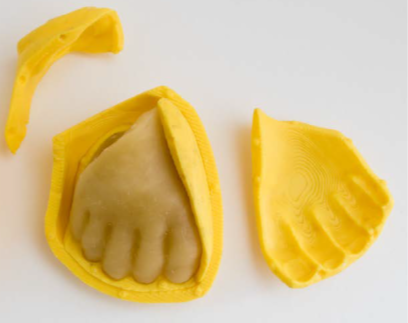Digitization and 3D printing for the reconstruction of volumetric losses in an anatomical wax model of the 18th century
DOI:
https://doi.org/10.14568/cp2018003Keywords:
Photogrammetry, Digital technologies, Conservation-restoration, Ceroplastic, Scientific collectionsAbstract
The three-dimensional models of wax belonging to the scientific heritage of the Complutense University of Madrid are a rare and extraordinary material that deserves to be preserved because it has great relevance to understand how surgeons and anatomists found formulas of visual construction that made possible the diffusion of his knowledge about the human body. In the present investigation, an anatomical wax model of the 18th century, with a remarkable degree of structural deterioration and weakness, has been restored, testing a new volumetric loss reconstruction methodology based on photogrammetric digitization of the sculpture, 3D modelling of the lost pieces and 3D printing of their moulds to obtain from them the final copies in waxy material. Due to this methodology, it has been possible to reduce the handling of the figure during the restoration process and the risk of accidental deterioration has been minimized.
Received: 2018-1-29
Revised: 2018-4-17
Accepted: 2018-6-2
Online: 2018-6-11
Publication: 2019-1-10
Downloads
References
[1] De Chandarevian, S.; Hopwood, N. (eds.), Models: The Third Dimension of Science, Stanford University Press, Stanford (2004).
[2] Maerker, A., 'Anatomizing the trade: designing and marketing anatomical models as medical technologies, ca. 1700-1900', Technology and Culture 54(3) (2013) 531-562, https://doi.org/10.1353/tech.2013.0108.
[3] Haviland, T. N.; Parish, L. C., 'A brief account of the use of wax models in the study of Medicine', Journal of the History of Medicine and Allied Sciences 25(1) (1970) 52-75, https://dx.doi.org/10.1093/jhmas/XXV.1.52.
[4] Talairach-Vielmas, L., 'Anatomical models: a history of disappearance?', Histoire, Médecine et Santé 5 (2014) 9-20.
[5] 'The Leiden declaration on human anatomy/anatomical collections' (2012), International Conference on 'Cultures of Anatomical Collections', held at Leiden University, Leiden University, http://media.leidenuniv.nl/legacy/leiden-declaration.pdf (acceso en 2018-6-10).
[6] Pierdicca, R.; Frontoni, E.; Malinverni, E. S.; Colosi, F.; Orazi, R., 'Virtual reconstruction of archaeological heritage using a combination of photogrammetric techniques: Huaca Arco Iris, Chan Chan, Peru', Digital Applications in Archaeology and Cultural Heritage 3(3) (2016) 80-90, https://doi.org/10.1016/j.daach.2016.06.002.
[7] Scopigno, R.; Cignoni, P.; Pietroni, N.; Callieri, M.; Dellepiane, M., 'Digital fabrication techniques for cultural heritage: a survey', Computer Graphics Forum 36(1) (2017) 6-21, https://doi.org/10.1111/cgf.12781.
[8] Di Paola F., 'Digital technologies for virtual recomposition: the case study of Serpotta stuccoes', Journal of the Malta Chamber of Scientists 3(1) (2015) 63-68, https://doi.org/10.7423/XJENZA.2015.1.09.
[9] Charbonnier, B.; Laurent, C.; Blanc, G.; Valfort, O.; Marchat, D., 'Porous bioceramics produced by impregnation of 3d-printed wax mold: ceramic architectural control and process limitations', Advanced Engineering Materials 18(10) 1728-1737, https://doi.org/10.1002/adem.201600308.
[10] Rodriguez, R. U.; Kemper, N.; Breathwaite, E.; Dutta, S. M.; Hsu, E. L.; Hsu, W. K.; Francis, M. P., 'Demineralized bone matrix fibers formable as general and custom 3D printed mold-based implants for promoting bone regeneration', Biofabrication 8(3) (2016) 035007, https://doi.org/10.1088/1758-5090/8/3/035007.
[11] Arbace, L.; Sonnino, E.; Callieri, M.; Dellepiane, M.; Fabbri, M.; Iaccarino Idelson, A.; Scopigno, R., 'Innovative uses of 3D digital technologies to assist the restoration of a fragmented terracotta statue', Journal of Cultural Heritage 14(4) (2013) 332-345, https://doi.org/10.1016/j.culher.2012.06.008.
[12] Dacome, L., Malleable Anatomies. Models, Makers, and Material Culture in Eighteenth-Century Italy, Oxford University Press, Oxford (2017).
[13] Azzaroli Puccetti, M. L.,'Human anatomy in wax during the Florentine Enlightenment', Italian Journal of Anatomy and Embriology 102(2) (1997) 77-89.
[14] Maerker, A., Models Experts: Wax Anatomies and Enlightenment in Florence and Vienna, 1775-1815, Manchester University Press, Manchester (2011).
[15] Maerker, A., 'Florentine anatomical models and the challenge of medical authority in late-eighteenth-century Vienna', Studies in History and Philosophy of Science 43(3) (2012) 730-40, https://doi.org/10.1016/j.shpsc.2012.02.005.
[16] Usandizaga, M., Historia del Real Colegio de Cirugía de San Carlos de Madrid (1787-1828), Consejo Superior de Investigaciones Científicas, Madrid (1948).
[17] Burke, M. E., The Royal College of San Carlos. Surgery and Spanish Medical Reform in the Late Eighteenth Century, Duke University Press, Durham (1977).
[18] Sánchez, A.; Del Moral, N.; Micó, S., 'Entre la Ciencia y el Arte. Ceroplástica anatómica para el Real Colegio de Cirugía de San Carlos (1786-1805)', Archivo Español de Arte 85(340) (2012) 329-349, https://doi.org/10.3989/aearte.2012.v85.i340.518.
[19] 'Libro de representaciones, respuestas y ordenanzas, y Reales Ordenes con arreglo a la rdenanza de cirugía. Madrid, 1787-1815', manuscrito, Archivo General de la Universidad Complutense, Madrid, BH UCM, Mss 927.
[20] Massey, L., 'Pregnancy and pathology: picturing childbirth in eighteenth-century obstetric atlases', The Art Bulletin 87(1) (2005) 73-91, https://doi.org/10.1080/00043079.2005.10786229.
[21] Smellie, W., A Sett of Anatomical Tables, With Explanations and an Abridgement of the Practice of Midwifery: With a View to Illustrate a Treatise on That Subject, and Collection of Cases, London (1754).
[22] Bonells, J.; Lacaba, I., Curso Completo de Anatomía del Cuerpo Humano, vol. 5, Imprenta de Sancha, Madrid (1800).
[23] Sánchez, A.; Matia, P., 'Modelos plásticos o simulacros de carne. Procedimientos tecnológicos en la creación de esculturas en cera', De Arte 15 (2016) 310-326, https://doi.org/10.18002/da.v0i15.

Downloads
Published
How to Cite
Issue
Section
Categories
License
This work is distributed under a Creative Commons Attribution License (CC BY-NC-ND 4.0) which permits use, distribution, and reproduction in any medium following no commercial or derivatives, provided the original author and source are credited.
Copyright remains with the authors.






